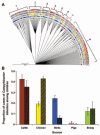Attribution of Campylobacter infections in northeast Scotland to specific sources by use of multilocus sequence typing
- PMID: 19265482
- PMCID: PMC3985119
- DOI: 10.1086/597417
Attribution of Campylobacter infections in northeast Scotland to specific sources by use of multilocus sequence typing
Abstract
We show that a higher incidence of campylobacteriosis is found in young children (age, <5 years) living in rural, compared with urban, areas. Association of this difference with particular animal sources was evaluated using multilocus sequence typing. This evaluation was achieved by comparing Campylobacter isolates originating from these children, retail poultry, and a range of animal sources by use of source attribution and phylogenetic analysis methods. The results indicate that chicken is a major source of infection in young urban children, although not in their rural counterparts, for which ruminant and other avian sources are more important.
Figures


Similar articles
-
Campylobacteriosis in urban versus rural areas: a case-case study integrated with molecular typing to validate risk factors and to attribute sources of infection.PLoS One. 2013 Dec 26;8(12):e83731. doi: 10.1371/journal.pone.0083731. eCollection 2013. PLoS One. 2013. PMID: 24386265 Free PMC article.
-
Human Campylobacteriosis in Luxembourg, 2010-2013: A Case-Control Study Combined with Multilocus Sequence Typing for Source Attribution and Risk Factor Analysis.Sci Rep. 2016 Feb 10;6:20939. doi: 10.1038/srep20939. Sci Rep. 2016. PMID: 26860258 Free PMC article.
-
Risk factors for campylobacteriosis of chicken, ruminant, and environmental origin: a combined case-control and source attribution analysis.PLoS One. 2012;7(8):e42599. doi: 10.1371/journal.pone.0042599. Epub 2012 Aug 3. PLoS One. 2012. PMID: 22880049 Free PMC article.
-
A combined case-control and molecular source attribution study of human Campylobacter infections in Germany, 2011-2014.Sci Rep. 2017 Jul 11;7(1):5139. doi: 10.1038/s41598-017-05227-x. Sci Rep. 2017. PMID: 28698561 Free PMC article.
-
A systematic review of source attribution of human campylobacteriosis using multilocus sequence typing.Euro Surveill. 2019 Oct;24(43):1800696. doi: 10.2807/1560-7917.ES.2019.24.43.1800696. Euro Surveill. 2019. PMID: 31662159 Free PMC article.
Cited by
-
Increased risk for Campylobacter jejuni and C. coli infection of pet origin in dog owners and evidence for genetic association between strains causing infection in humans and their pets.Epidemiol Infect. 2013 Dec;141(12):2526-35. doi: 10.1017/S0950268813000356. Epub 2013 Feb 28. Epidemiol Infect. 2013. PMID: 23445833 Free PMC article.
-
Systematic Review and Meta-Analysis of Campylobacter Species Contamination in Poultry, Meat, and Processing Environments in South Korea.Microorganisms. 2023 Nov 7;11(11):2722. doi: 10.3390/microorganisms11112722. Microorganisms. 2023. PMID: 38004735 Free PMC article. Review.
-
Molecular epidemiology of Campylobacter jejuni in a geographically isolated country with a uniquely structured poultry industry.Appl Environ Microbiol. 2010 Apr;76(7):2145-54. doi: 10.1128/AEM.00862-09. Epub 2010 Feb 12. Appl Environ Microbiol. 2010. PMID: 20154115 Free PMC article.
-
Campylobacter excreted into the environment by animal sources: prevalence, concentration shed, and host association.Foodborne Pathog Dis. 2009 Dec;6(10):1161-70. doi: 10.1089/fpd.2009.0327. Foodborne Pathog Dis. 2009. PMID: 19839759 Free PMC article.
-
Consumer acceptability of interventions to reduce Campylobacter in the poultry food chain.Food Control. 2014 Jan;35(1):260-266. doi: 10.1016/j.foodcont.2013.06.005. Food Control. 2014. PMID: 24882947 Free PMC article.
References
-
- Centers for Disease Control and Prevention Preliminary FoodNet data on the incidence of infection with pathogens transmitted commonly through food—10 states, 2006. MMWR Morb Mortal Wkly Rep. 2007;56:336–9. - PubMed
-
- Locking M, Browning L, Smith-Palmer A, Brownlie S. Gastro-intestinal and foodborne infections. HPS Weekly Report. 2007;41:3–4.
-
- Stanley K, Jones K. Cattle and sheep farms as reservoirs of Campylobacter. J Appl Microbiol. 2003;94:104S–13S. - PubMed
Publication types
MeSH terms
Grants and funding
LinkOut - more resources
Full Text Sources
Medical

